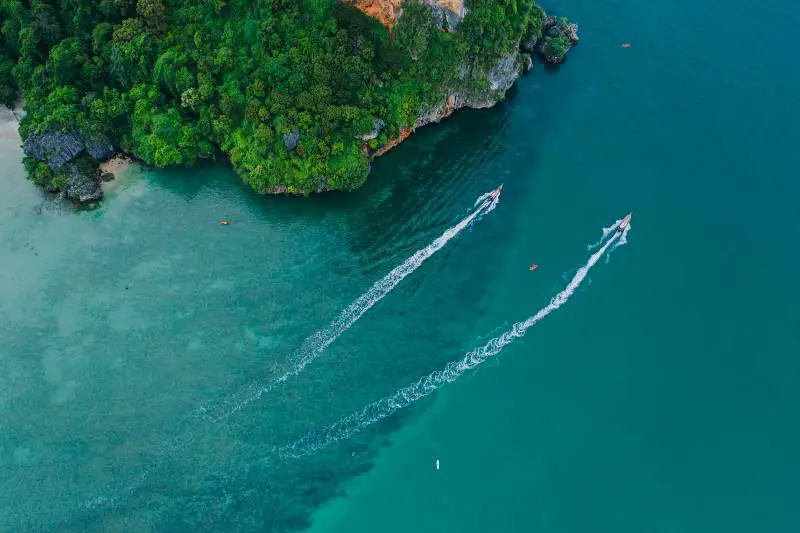Thailand’s Dance with Tourism: A Deep Dive
From majestic mountains and lush rainforests teeming with wildlife to pristine beaches and the vibrant culture of bustling cities, Thailand has something for everyone. With its breathtaking landscapes and friendly people, it’s no wonder why it is one of the most popular tourist destinations in the world. But what lies beneath the beauty of this nation? How does tourism really affect Thailand both on a macroeconomic level as well as within its communities?
In this blog post, we’ll take an in-depth look into how tourism has impacted Thailand’s economy, culture, environment, and more. From economic benefits to potential pitfalls that have resulted from increasing numbers of tourists coming into the country every year – we’ll explore all sides of the story so you can better understand how travel affects life in Thailand today.
Thailand’s tourism industry has approximately 25 million visitors annually. From budget-conscious backpackers to those seeking luxury, the country caters to a diverse range of travelers, offering a wide array of accommodations and activities to suit their varied preferences.
Key Takeaways
- While tourism significantly bolsters Thailand’s economy, it also brings about notable environmental challenges, especially concerning natural resources.
- Tourism fosters rich cultural exchange, but it also risks commercializing and diluting genuine local traditions and practices.
- Given the challenges posed by over-tourism, there’s a growing emphasis on sustainable travel to ensure Thailand’s beauty and heritage remain intact for future generations.

Historical Context of Tourism in Thailand
Thailand, with its lush landscapes, rich cultural heritage, and sun-kissed beaches, has long been the crown jewel of Southeast Asian tourism. The story of how this nation emerged as one of the world’s most sought-after travel destinations is as colorful and diverse as its landscapes and traditions.
The emergence of Thailand as a Travel Destination
The seeds of Thailand’s tourism sector were planted in the early 20th century, yet it wasn’t until after World War II that the nation truly began to gain international attention. The country’s strategic geographical location made it an attractive stopover for military personnel during the Vietnam War era. With this came the establishment of entertainment districts, some of which still exist today, albeit transformed.
In the 1960s and ’70s, the allure of Thailand’s pristine beaches, especially places like Phuket and Pattaya, began to spread among backpackers and intrepid travelers from the West. Films such as “The Man with the Golden Gun” in 1974, showcasing the stunning Phang Nga Bay, played a role in bringing visual evidence of Thailand’s beauty to international audiences.
To put it simply, it was as if the world had discovered a well-kept secret, a land of tantalizing cuisines, mesmerizing dances, and sacred temples glittering under the tropical sun. The Thai government, recognizing the potential of this burgeoning sector, launched the “Visit Thailand Year” campaign in 1987, further solidifying the country’s status as a premier global destination.
Evolution of Tourism Trends over the Decades:
- The Backpacker Era (1980s – 1990s): As previously mentioned, the latter half of the 20th century saw an influx of backpackers, drawn by the promise of affordable travel and authentic cultural experiences. Places like Khao San Road in Bangkok became iconic, with its budget accommodations, lively nightlife, and eclectic mix of international tourist arrivals seeking adventures off the beaten path.
- Rise of the Luxury Traveler (2000s): With the new millennium came a shift towards luxury tourism. Five-star resorts, spa retreats, and boutique hotels began to sprout across the islands and cities. Destinations like Koh Samui and the Phi Phi Islands catered to travelers seeking both comfort and beauty. The idea was simple yet compelling: experience the majesty of Thailand without forgoing the luxury.
- Eco-Tourism and Community-Based Tourism (2010s): As global awareness about environmental sustainability grew, Thailand adapted once again. Destinations like Chiang Mai in the north became centers for eco-tourism, offering elephant sanctuaries that prioritized animal welfare, and homestays that allowed tourists to experience local life firsthand. It was tourism with a purpose, connecting visitors not just with sights, but with communities and causes.
- Digital Nomadism and Workation (Late 2010s – 2020s): With the rise of remote work and the digital economy, cities like Chiang Mai and Bangkok became hubs for digital nomads. These are professionals who blend work with travel, often staying for extended periods in co-working and co-living spaces. The ‘workation’ trend, especially in the wake of the COVID-19 pandemic, further solidified Thailand’s appeal, offering a blend of work-life balance in a tropical paradise.
- Health and Wellness Tourism (2020s): As global travelers became more health-conscious, Thailand’s wellness retreats, yoga sanctuaries, and holistic health resorts came into the limelight. From detox programs in Koh Phangan to meditation retreats in Pai, Thailand offered a respite for the body, mind, and soul.
Economic Impacts
Economic Impacts of Tourism in Thailand
Thailand, often affectionately called the “Land of Smiles”, has long been a beacon for travelers, drawing millions annually to its vibrant cities, paradisiacal islands, and rich cultural tapestry. But beyond its aesthetic allure, tourism has also been a significant economic powerhouse for the nation, deeply influencing its GDP growth, employment landscape, and infrastructure development.
Contribution of Tourism to Thailand’s GDP:
It’s undeniable that tourism plays a pivotal role in bolstering Thailand’s economy. Before the unforeseen circumstances brought about by the COVID-19 pandemic, tourism consistently accounted for a significant chunk of the nation’s GDP. To paint a clearer picture, in 2019, the tourism authority’s direct contribution to Thailand’s GDP stood at approximately 12%, a testament to its immense economic value.
But when you factor in indirect contributions, such as investment in tourism-related projects and the multiplier effect where money spent by tourists circulates through the economy, that number rises substantially, sometimes estimated to be over 20%. In tangible terms, this means that for every $5 generated in Thailand’s economy, roughly $1 could be traced back to a tourist’s pocketbook.
Job Creation and Employment Opportunities in the Tourism Sector:
Tourism is not just about picturesque beaches and temples; it’s a veritable lifeline for millions of Thais. This industry is a significant employer in the nation. From the bustling street markets of Bangkok where vendors peddle everything from spicy pad thai to handcrafted souvenirs, to the diving instructors of Koh Tao and the elegant spa therapists of luxury resorts, a vast tapestry of jobs exists due to the influx of tourists.
Before the pandemic, it was estimated that nearly 4.4 million jobs in Thailand, directly or indirectly, were anchored in the tourism sector, which encompasses a wide range of professions, including hospitality, transport, food services, tour operations, and many others. This indicates that a significant percentage of the Thai workforce is, in one way or another, intertwined with the fate of the tourism industry.
Development of Infrastructure Due to Tourism:
Infrastructure in many regions of Thailand has seen exponential growth and development, largely spurred by the demands of tourism. Airports like Phuket International and Suvarnabhumi in Bangkok have undergone expansions and renovations to accommodate the ever-growing influx of travelers. Similarly, road networks, especially in popular tourist regions, have been improved to facilitate easier transportation.
Furthermore, there’s been significant investment in public transportation. Bangkok’s Skytrain (BTS) and Metro (MRT), for instance, offer tourists a convenient way to navigate the sprawling city, while also easing local commutes. Beyond transportation, the demand for better amenities has led to the development of shopping malls like ICONSIAM, luxury resorts, world-class entertainment venues, and even state-of-the-art hospitals catering to medical tourists.
Yet, it’s worth noting that while tourism-driven infrastructure can boost local economies and enhance convenience, it’s essential to strike a balance. Overdevelopment, if unchecked, might harm the very natural beauty and cultural heritage that tourists come to experience.
The economic footprints of tourism in Thailand are vast, shaping its GDP, providing livelihoods to millions, and steering the course of its infrastructure development. As travelers, when we set foot on Thailand’s shores, we’re not just witnessing its history and culture but also playing a role in its economic narrative, a testament to the intertwined relationship between a country and its visitors.
Cultural Impacts
Thailand, often epitomized by its serene temples, vibrant festivals, and legendary hospitality, possesses a deep-seated cultural identity. As with any major tourist destination, the influx of visitors has undeniably influenced this cultural landscape, leading to an intricate dance between preservation and evolution.
1. Influence on Local Traditions and Practices:
The impact of tourism on local traditions can be a double-edged sword. On the positive side, the global interest in Thai culture has often led to the revitalization of certain traditions and practices. Festivals like Songkran (the Thai New Year water festival) or Loi Krathong (the festival of lights) draw both locals and tourists, ensuring that these age-old traditions remain vibrant and continue to be celebrated with gusto.
However, in some cases, traditions have been modified or “watered-down” to cater to tourists. An example might be certain traditional Thai dance performances in popular tourist areas which, while still beautiful, might be shortened or altered to fit into a commercialized, entertainment package.
Another example is the famed “Floating Markets” which, while originally a genuine aspect of local life in certain regions, have in some places transformed into primarily tourist attractions, losing some of their authenticity in the process.
2. Commercialization of Cultural Heritage Sites:
Thailand is home to a treasure trove of cultural heritage sites, from the ancient ruins of Ayutthaya to the sacred temples of Chiang Mai. The influx of tourism has necessitated the development of facilities like souvenir shops, restaurants, and tour services around these sites. While this aids in economic growth, there’s a palpable risk of over-commercialization. In some instances, the spiritual or historical ambiance of these sites can be overshadowed by the hustle and bustle of commerce.
A balance, however, is often sought. The revenue generated from tourism-related activities can be funneled back into preservation efforts. For example, entrance fees to certain historical sites are used for maintenance and restoration, ensuring that these places can be enjoyed by future generations.
3. Interaction between Locals and Tourists:
Interactions between locals and tourists can be a source of mutual enrichment. Tourists get to immerse themselves in Thai culture, learning firsthand about local customs, values, and ways of life. Conversely, locals, especially in tourist-centric areas, get exposed to a medley of global cultures and perspectives, fostering a sense of cosmopolitanism.
However, there can be friction points. With millions of tourists visiting annually, some locals might feel overwhelmed or disillusioned, especially if they perceive tourists as being disrespectful towards local customs or sacred sites. It’s not uncommon, for instance, to see reminders for tourists to dress modestly when visiting temples.
Moreover, the “tourist bubble” phenomenon can sometimes limit genuine interactions. In areas heavily frequented by tourists, interactions can become transactional, with locals viewing tourists primarily as customers and vice versa. This can sometimes lead to missed opportunities for deeper cultural exchange.
In conclusion, the cultural impact of tourism in Thailand is multifaceted. While there are undeniable benefits like economic upliftment and the global appreciation of Thai culture, challenges such as commercialization and potential cultural dilution exist. The onus rests on both travelers and locals alike to engage with each other respectfully and authentically, ensuring that the rich tapestry of Thai culture remains vibrant and cherished for ages to come.
Environmental Impacts
Thailand’s enchanting landscapes, from its azure waters to its verdant jungles, have captivated the hearts of countless visitors. However, with the blessings of its natural beauty come the environmental challenges posed by the surge of tourism. Understanding these impacts helps in appreciating the delicate balance between enjoying nature’s wonders and preserving them for future generations.
1. Impact on Natural Resources:
- Beaches: Thailand’s beaches are among its most famous attractions, drawing millions to their sun-soaked sands. But such popularity comes at a cost. Overcrowding can lead to erosion, littering, and even pollution from boats and water sports activities. The famed Maya Bay on Koh Phi Phi Leh, popularized by the movie “The Beach”, had to be closed to tourists for a while to allow its ecosystem to recover from damage.
- Coral Reefs: The country’s coral reefs, teeming with marine life, have sadly been under threat. Factors include damage from anchors, littering, sunscreen pollutants, and even the simple act of tourists touching the corals while snorkeling or diving. The cumulative impact weakens these fragile ecosystems, making them susceptible to diseases and bleaching.
- Wildlife: The lure of exotic wildlife experiences can sometimes overshadow ethical considerations. Elephant rides, a popular tourist activity, have come under scrutiny for the welfare of the animals involved. Similarly, attractions that feature tigers, monkeys, and other wildlife can sometimes prioritize tourist satisfaction over animal well-being.
2. Waste Management and Ecological Footprint:
Tourism invariably brings with it an increase in waste, both solid and liquid. Popular tourist destinations, especially islands with limited land area, can struggle to manage the sheer volume of trash generated, including plastics. Inadequate waste management systems, combined with the transient nature of tourism, can result in littered beaches and polluted waters. Additionally, the carbon footprint from air travel, local transport, and energy consumption in hotels and resorts contributes to the overall environmental impact.
3. Conservation Efforts Induced by Tourism:
While the environmental challenges are substantial, tourism has also sparked positive change:
- Awareness and Education: The very fact that environmental degradation has been highlighted is largely due to the global attention these tourist spots receive. This awareness can lead to better education for both tourists and locals about eco-friendly practices.
- Eco-Tourism: There’s a growing trend towards eco-tourism in Thailand, emphasizing sustainability and minimal impact on the environment. Such initiatives often prioritize local community involvement, ensuring that revenue goes back into the community while conserving the environment.
- Conservation Funding: Entrance fees to national parks, marine reserves, and other protected areas are channeled back into conservation efforts. This revenue is vital for maintaining these areas, funding patrols, and implementing restoration efforts.
- Temporary Closures: As seen with Maya Bay, authorities are willing to make tough decisions for environmental recovery, closing off areas to allow nature to rejuvenate. These actions, while challenging in the short term, underscore a commitment to long-term sustainability.
In the grand tapestry of Thailand’s tourism story, the environment plays a starring role. While the challenges are real and pressing, the potential for positive change exists. It hinges on collective responsibility: governments setting regulations, businesses adopting sustainable practices, and tourists traveling with consciousness and care. The dream? That the shimmering beaches, vibrant coral reefs, and lush jungles of Thailand continue to inspire awe for countless generations ahead.
Challenges Faced by Thailand Due to Tourism
Thailand’s allure as a global tourism hotspot is indisputable. With its unique blend of ancient temples, bustling cities, tranquil beaches, and delectable cuisine, it stands as one of the world’s most visited destinations. However, with such immense popularity come a series of challenges that the nation grapples with.
1. Over-tourism and Its Consequences:
Over-tourism is perhaps the most visible and discussed challenge. It refers to the situation where too many visitors flock to a destination, leading to a myriad of problems.
- Environmental Degradation: As previously touched upon, popular destinations can suffer extensive environmental damage. Beaches can become eroded, marine life disturbed, and the local flora and fauna jeopardized due to sheer visitor numbers. Places like Maya Bay experienced such extensive damage that a temporary closure became imperative for ecological recovery.
- Cultural Erosion: The constant flow of tourists, if unchecked, can sometimes lead to the dilution of local customs and traditions. Festivals and rituals might be altered to fit tourist expectations, and local practices could be commercialized to the point where their original essence is lost.
- Infrastructure Strain: The infrastructural fabric of popular tourist areas — from roads to sewage systems — faces enormous pressure from the sheer volume of visitors. This can lead to wear and tear, congestion, and a decline in the quality of facilities.
2. Pressure on Local Resources:
- Water and Energy Consumption: Tourist establishments, especially luxury hotels and resorts, can consume vast amounts of water and energy. In areas where resources are already scarce, this can exacerbate shortages, impacting local communities adversely.
- Food and Commodities: The increased demand for food and other commodities can sometimes lead to price hikes, making essential goods more expensive for locals. In coastal areas, for instance, the demand for seafood by tourists might deprive local communities of their staple diet.
- Land Use: The construction of hotels, resorts, and other tourist facilities can lead to a change in land use patterns, sometimes at the expense of agricultural lands or local habitats.
3. Impact on Local Communities:
- Economic Disparity: While tourism can undoubtedly bring prosperity, the benefits are not always equitably distributed. There might be a stark contrast between the affluence of tourist-heavy areas and the relative poverty of areas untouched by tourism.
- Cultural Misunderstandings: Interactions between tourists and locals can sometimes lead to misunderstandings or conflicts, especially if tourists are unaware or dismissive of local customs and sensibilities.
- Gentrification: Popular tourist areas might undergo gentrification, with local establishments being replaced by more upscale, tourist-friendly businesses. This can lead to locals feeling alienated in their own neighborhoods.
In conclusion, while tourism has showered Thailand with numerous benefits, both economic and cultural, the challenges it presents are substantial. Addressing these requires a multi-pronged approach, involving sustainable tourism practices, government regulations, local community involvement, and responsible tourist behavior. The dream is to maintain Thailand’s status as a coveted destination while ensuring that its natural beauty, cultural richness, and community well-being remain unblemished.
The Future of Tourism in Thailand
The future of tourism in Thailand holds immense promise, shaped by global trends, local initiatives, and an evolving consciousness about sustainability. Amidst challenges, the country is carving a path that seeks to harmoniously blend tourism growth with environmental and cultural preservation.
1. Sustainable Tourism Initiatives:
- Eco-Tourism: Thailand is making strides in promoting eco-tourism, which emphasizes responsible travel to natural areas, ensuring minimal impact and fostering environmental and cultural understanding. Destinations like Chiang Mai are becoming hubs for eco-tourism, offering experiences ranging from sustainable elephant sanctuaries to community-based trekking.
- Green Hotels and Resorts: A rising number of accommodations are seeking green certifications, implementing practices like water conservation, renewable energy usage, and waste reduction.
- Marine Conservation: Given the pressure on marine ecosystems, initiatives such as coral reef restoration and sustainable diving practices are gaining traction.
2. Strategies Adopted by the Government and Private Sector:
- Zoning and Carrying Capacities: Authorities are considering zoning strategies to define areas based on their suitability for different tourist activities. This is coupled with determining the ‘carrying capacity’ of popular sites, ensuring they don’t get overwhelmed by visitors.
- Promoting Lesser-Known Destinations: To alleviate the pressure on perennial favorites, there’s a push towards promoting off-the-beaten-path destinations. This not only ensures a more equitable distribution of tourism revenue but also introduces visitors to diverse Thai experiences.
- Digital Platforms for Tourism: Digital transformation is playing a role in enhancing the tourist experience. Apps and platforms offer insights into sustainable travel options, cultural dos and don’ts, and real-time feedback mechanisms.
- Quality over Quantity: The focus is gradually shifting from merely increasing tourist numbers to enhancing the quality of the tourist experience, thereby ensuring longer stays and responsible behavior.
3. Expected Trends and Shifts:
- Cultural Immersion: The modern traveler seeks authentic experiences. This will likely lead to a rise in community-based tourism where visitors can immerse themselves in local ways of life, from crafts to culinary traditions.
- Health and Wellness Tourism: Thailand’s spa and wellness sector, rooted in ancient practices like Thai massage, is expected to grow. Moreover, wellness retreats focusing on meditation, detox, and yoga are seeing rising popularity.
- Tech-Driven Experiences: Augmented reality (AR) and virtual reality (VR) might soon enhance historical and cultural site visits, offering deeper insights and interactive experiences.
- Resilience and Preparedness: Given global challenges like pandemics and climate change, there’s likely to be an emphasis on resilience, with infrastructural developments and policies focusing on future readiness.
In the evolving narrative of Thailand’s tourism, the future chapters seem to be penned with care, vision, and a commitment to balance. While global challenges persist, with concerted efforts from the government, private sector, and travelers, Thailand’s tourism tapestry will likely remain vibrant, diverse, and sustainable. The Land of Smiles promises not just unforgettable experiences but also a blueprint for responsible and meaningful travel.

The Impact of Tourism on Thailand FAQs
Are there regions in Thailand more impacted by tourism than others?
Yes, certain regions in Thailand such as Bangkok, Pattaya, Phuket, and Krabi tend to experience higher levels of tourism. These places are popular destinations for both domestic tourism and international tourism travelers which can lead to overcrowding and environmental stress. However, there is an increasing focus on promoting lesser-known tourist spots and exploring alternative forms of sustainable tourism.
How are local communities affected by tourism?
Tourism can bring both positive and negative impacts on local communities. On the one hand, it can create job opportunities and provide economic growth. However, it can also lead to increased prices of goods and services, rent hikes, and displacement of locals. Additionally, cultural exchange may lead to misunderstandings between tourists and locals which can cause conflicts.
How has the Thai government responded to the challenges posed by tourism?
The Thai government has implemented a variety of strategies to ensure that tourism is balanced and sustainable. These include zoning regulations, carrying capacities, promoting lesser-known destinations, digital transformation for tourism activities, and improving the quality of the tourist experience.
Are there any indigenous practices or sites threatened by over-tourism?
Yes, indigenous practices such as traditional music and dance performances may be threatened by over-tourism. In addition, some historical sites may not be able to withstand the influx of visitors.
What are the major infrastructural developments due to tourism in Thailand?
Infrastructural developments due to tourism in Thailand include roads leading to popular tourist destinations, improved transportation links, upgraded airports, and seaports, additional accommodation options, and more. Additionally, the Thai government is investing in resilience-building measures such as pandemic preparedness plans.
Conclusion
Thailand is undoubtedly a beautiful destination rich in culture and exceptional hospitality—attributes only fortified by the robust tourism industry worldwide. However, there are potential challenges like environmental destruction and the homogenization of regional customs that may arise due to overcrowded tourist sites.
It’s important that those considering a visit to Thailand support sustainable tourism initiatives in order to minimize their impact on natural landscapes. Moreover, travelers should do their own research into sharing respectfully with locals as part of maintaining open dialogue in our global community.
Finally, while delays and technological hiccups can happen, individuals are encouraged to plan ahead to avoid unnecessary disruption when visiting Thailand. At the end of the day, if you consider all these complexities involved with responsible travel, then your journey could be even more rewarding as you retain its genuine charm for years to come. Subscribe to our newsletter for the best information about living in Thailand or reach out to us with any specific questions that you have about your visit.






